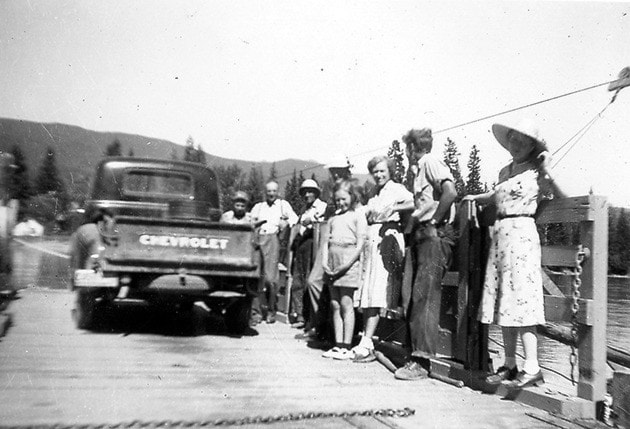Editor’s Note: The following is the first of a two-part history that was written by Ina T. Fairbrother in 1969 and then appeared in the Oct. 30 and Nov. 7, 1974 issues of the Times.
Part two will appear in our Nov. 3 issue.
Ina T. Fairbrother
Situated on the east side of the North Thompson River in a valley 70 miles from Kamloops is the settlement of Blackpool. The area has a long and colourful history.
John Harley Miller, the man who named Blackpool, left England in 1898 for Alberta.
Mainly by walking, he made his way across to British Columbia and arrived in the area in 1906. With the Forestry Department then, Mr. Miller pre-empted 320 acres in compliance with the requirement that he own land and be a permanent resident before he open a post office.
Between 1900 and 1920 the district from Round Top to Clearwater was settled. Almost every arable piece of land was taken up.
In those days the only access to Blackpool was the Tete Jaune Trail, built in 1876, and still in use at Dunn Lake.
Originally the area was called Mosquito Flats, a term given because of the abundance of sloughs, ravines and uncleared land. The title never became official, however, because most of the citizens contended the mosquitoes were no more numerous there than elsewhere in the North Thompson Valley.
Meantime, citizens had begun to rebuild following a fire in 1908 that razed the small community to the ground leaving nothing but ruins and ashes.
John Miller became the first postmaster in 1910. He called his office Auldgirth, the equivalent of Old Village.
Though by this time he had become a respected member of the community and the owner of a homestead, the young bachelor felt lonely in his adopted land.
More and more his thoughts turned to the childhood sweetheart he had left in England.
Hence to the letter he subsequently wrote, Mr. Miller received a prompt reply.
Soon Miss Mary Ashenhurst came from England to Kamloops, where she again met her husband-to-be. In 1911 they were married at St. Paul’s, a little log church on the then main street in Kamloops (now known as Victoria Street).
Blackpool’s first family included two lovely daughters. Mrs. Miller, now a widow, lives near Vancouver. Her two daughters are married and have families of their own.
Whitey McGinnes carried mail from Kamloops to Louis Creek. Eddie Fortier then took it as far as Heywood’s Crossing at Mile 71. In those days travelling and transportation of supplies depended on mules, horses and freight wagons. Talk of the days of the Pony Express.
Construction of the CNR main line, known then as the Canadian Northern Railway, was a main factor in the settlement of this area. It was contracted by McKenzie and Mann in 1913, and completed in 1915. Two of the many men who worked on it were John Beatman and Mike Beretanos.
What is now the site of Blackpool was once a very heavy stand of cedar and fir.
The flat stretched south to the foot of the hill and north to the ferry crossing was acquired by George Fennel of Chu Chua. This timber was logged off for use as railway ties and poles.
A few of the loggers in the area at that time were Billy Hewitt, William McCarthy, Neil MacLennan, Billy Douglas and a man called Ruddick.
Jack Schlichter hauled for construction of the railway. Starting from Kamloops, he drove the freight wagons, changing horses and mules along the way.
He went as far as Mile 71, where there was a boarding house, police station and the Clearwater Post Office.
Trees growing in the two cells of the police station were ideal for handcuffing prisoners to at night.
Mr. Schichter had settled at Blackpool in 1912 at the Queen Bess Mine. Mrs. Schlichter remembers the charivari soon after they were married in 1919. Her husband became a railroad foreman at Jackman, B.C. before his retirement.
A Mr. Marshall was the operator at Clearwater as well as being the first ferryman.
The ferry, called the Raft River Ferry, landed at Glen Eddy on the west side, then known as Heywood Crossing. At this crossing still stands an old apple tree — a lone souvenir of the past. Bill Harley, Tom Treseng and R. Davoren also were ferrymen at different times.
The ferry was moved to the Blackpool site when the Alpha Bridge was built in 1923.
The new ferry was called the Blackpool Ferry. It was operated by Mr. Ruddick, who lived close by. In turn, a spring was named in honour of Mr. Ruddick.
The next ferryman was a Mr. Bester. He lived on the west side of the river. Walter Ward also lived there and ran the ferry for 27 years until his retirement.
Ernest Wallin and Angus McLeod ran it for short periods after that. The last ferryman, Mr. Henry W. Fairbrother, took over in 1950.
In 1914 the Queen Bess Mine was operating. Galena ore (silver, lead, zinc, and a trace of gold) was mined and gave employment to some of the early settlers.
The mine was situated three miles south of Blackpool Station.
Ben Foote was foreman, and Alex Miller was caretaker of the mine property for a time. A log building had been put up by the miners for entertainment.
Musicians were the Loffmark brothers of Chase, brothers of Mrs. Tom Treseng of Clearwater, and uncles of Honourable Ralph Loffmark, MLA.
There was a railroad spur and side track at the station until the mine closed down in 1928.
John Seiman of Kamloops once drilled for coal on the McCarthy place but found only a narrow seam.
